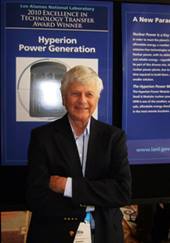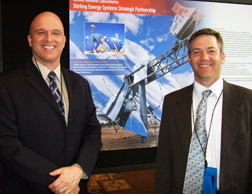Market, To Market, Bringing Technologies to Market
The Federal Laboratory Consortium (FLC) is the nationwide network of federal laboratories that provides a forum to develop strategies and opportunities to pair laboratories with private industry to bring government-developed technologies to market faster. The Department of Energy (DOE) laboratories won seven individual awards for Excellence in Technology Transfer from the FLC and were part of a team for one FLC Interagency Partnership Award.
"The FLC awards are a prestigious honor in the Federal technology transfer world. Most importantly, they demonstrate just a sampling of some of the truly great innovations that come out of our national laboratory system," said David Koegel of DOE's Office of Science, who serves as DOE's representative to the FLC. "Taking the lead out of solder and reducing pollution in exhaust are just two examples of how technology transfer can improve our everyday lives."
The 2010 projects awarded for technology transfer were developed at Ames National Laboratory, Los Alamos National Laboratory, National Energy Technology Laboratory, Pacific Northwest National Laboratory, and Sandia National Laboratory.
Dr. Iver Anderson and his team at Ames National Laboratory developed a lead-free soldering alloy. "The rapid commercialization of this lead-free solder has helped reduce the amount of lead used in manufacturing electronics and other consumer goods," said Anderson. This technology has been licensed by Johnson Manufacturing of Princeton; Iowa, Loctite-Multicore Solders of Richardson, Texas; and Great Britain, and Nihon-Superior of Japan.
 Photo Credit - David Koegel
Photo Credit - David Koegel
DOE scientists at Los Alamos National Laboratory were honored for their work on the Hyperion Power Module (HPM).
Dr. Kevin Ott was honored for his work at Los Alamos National Laboratory in collaboration with CleanAIR Systems Inc of Santa Fe, N.M. The engine exhaust cleaning technology operates over a full-range of temperatures and reduces nitrogen oxide emissions to the environment by more than 95 percent.
Drs. Peterson, Trapp, and McClure also from Los Alamos National Laboratory were honored for their work on the Hyperion Power Module (HPM) – the world's first small mobile reactor, which uses the energy of low-enriched uranium fuel that complies with the non-proliferation criteria of the Global Nuclear Energy Partnership. This technology has been licensed by Hyperion Power Generation, Inc.
National Energy Technology Laboratory scientists in collaboration with partners at Ames National Laboratory and Reaction Engineering international developed the Virtual Engineering Process Simulator Interface (VE-PSI), a technology to model and simulate immersive, interactive, three-dimensional virtual environments. "This technology will allow engineers to create virtual prototypes of new plant designs more efficiently and at a lower cost than ever before," said Stephen Zitney.
Two teams of Pacific Northwest National Laboratory scientists received the award for their collaboration with industry. Dr. Daniel Lόpez-Ferrer was honored for his work on a high-pressure enzymatic digestion system that accelerates the process of protein digestion while reducing the cost of the analyses for faster diagnosis in clinical settings. This technology was licensed to Pressure BioSciences, Inc. Drs. Lavender, Smith, Stephens, Lahman, Tenaglia, and Johnson coordinated with Sandvik Special Metals, LLC, and LSP Technologies, Inc., to develop a laser shock peening method to increase the life of tool-steel dies. This technology has reduced costs and increased productivity by limiting the need for tool changes, while resulting in increased worker safety.
 Photo Credit - David Koegel
Photo Credit - David Koegel
Dr. Chuck Andraka (DOE) worked with Stirling Energy Systems, Inc to bring the new concentrating solar power product, SunCatcher™, to market.
Scientists from Sandia National Laboratories were honored for two projects. Dr. Ron Brightwell led a team of scientists who developed a super computer architectural design and prototype, called Red Storm. The information was deployed to Cray, Inc, who commercialized this as the Cray XT3, which has since led to two follow-on products, Cray's flagship XT4 and XT5 systems. Among the XT line of machines is the Cray Jaguar XT5 at Oak Ridge National Laboratory, current rated the fastest supercomputer in the world. In addition, Dr. Chuck Andraka worked with Stirling Energy Systems, Inc to bring the new concentrating solar power product, SunCatcher™, to full commercialization.
Awardees received their honors on April 29, 2010 in Albuquerque, N.M. Nominations were made by member laboratories and judged by representatives from industry, academia, Federal laboratories, and State and Local government.
Organized in 1974 and formally chartered in 1986, the FLC is the nationwide network of federal laboratories that provides the forum to rapidly integrate research and development resources within the mainstream of the U.S. economy. Today, FLC boasts members from more than 250 Federal laboratories and centers and their parent departments and agencies.
This article was written by Stacy W. Kish

